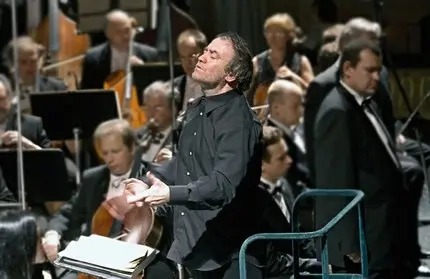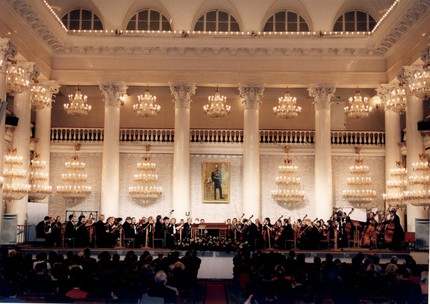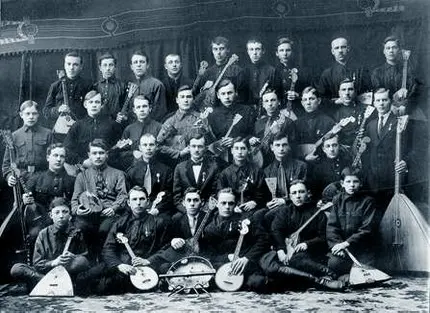
Orchestra of Russian Folk Instruments (The Ossipov Balalaika Orchestra) |
The Ossipov Balalaika Orchestra

The N. P. Osipov Academic Russian Folk Orchestra was founded in 1919 by balalaika virtuoso B. S. Troyanovsky and P. I. Alekseev (director of the orchestra from 1921 to 39). The orchestra included 17 musicians; the first concert took place on August 16, 1919 (the program included arrangements of Russian folk songs and compositions by V. V. Andreev, N. P. Fomin, and others). Since that year, the concert and musical and educational activities of the Russian Folk Orchestra began.
In 1921, the orchestra became part of the Glavpolitprosveta system (its composition increased to 30 performers), and in 1930 it was enrolled in the staff of the All-Union Radio Committee. Its popularity is expanding, and its influence on the development of amateur performances is increasing. Since 1936 – the State Orchestra of Folk Instruments of the USSR (the composition of the orchestra has increased to 80 people).
In the late 20s and 30s, the repertoire of the Russian Folk Orchestra was replenished with new works by Soviet composers (many of which were written specifically for this orchestra), including S. N. Vasilenko, H. H. Kryukov, I. V. Morozov , G. N. Nosov, N. S. Rechmensky, N. K. Chemberdzhi, M. M. Cheryomukhin, as well as transcriptions of symphonic works by Russian and Western European classics (M. P. Mussorgsky, A. P. Borodin, S. V. Rachmaninov, E. Grieg and others).
Among the leading performers are I. A. Motorin and V. M. Sinitsyn (domrists), O. P. Nikitina (guslar), I. A. Balmashev (balalaika player); orchestrators – V. A. Ditel, P. P. Nikitin, B. M. Pogrebov. The orchestra was conducted by MM Ippolitov-Ivanov, R. M. Glier, S. N. Vasilenko, A. V. Gauk, N. S. Golovanov, who had a beneficial effect on the growth of his performing skills.
In 1940 the Russian Folk Orchestra was led by the balalaika virtuoso N. P. Osipov. He introduced into the orchestra such Russian folk instruments as the gusli, Vladimir horns, flute, zhaleika, kugikly. On his initiative, soloists appeared on the domra, on the sonorous harp, duets of the harp, a duet of button accordions were created. Osipov’s activities laid the foundation for the creation of a new original repertoire.
Since 1943 the collective has been called the Russian Folk Orchestra; in 1946, after the death of Osipov, the orchestra was named after him, since 1969 – academic. In 1996, the Russian Folk Orchestra was renamed the National Academic Orchestra of Folk Instruments of Russia named after N.P. Osipov.
Since 1945, D. P. Osipov became the chief conductor. He improved some folk musical instruments, attracted the composer N. P. Budashkin to work with the orchestra, whose works (including Russian Overture, Russian Fantasy, 2 rhapsodies, 2 concertos for domra with an orchestra, concert variations for balalaikas with an orchestra) enriched the orchestra’s repertoire.
In 1954-62 the Russian Folk Orchestra was directed by V.S. Smirnov, from 1962 to 1977 it was headed by the People’s Artist of the RSFSR V.P.
From 1979 to 2004 Nikolai Kalinin was the head of the orchestra. From January 2005 to April 2009, the well-known conductor, professor Vladimir Alexandrovich Ponkin was the artistic director and chief conductor of the orchestra. In April 2009, the post of artistic director and chief conductor of the orchestra was taken by the People’s Artist of Russia, Professor Vladimir Andropov.
The repertoire of the Russian Folk Orchestra is unusually wide – from arrangements of folk songs to world classics. A significant contribution to the orchestra’s programs are the works of Soviet composers: the poem “Sergei Yesenin” by E. Zakharov, the cantata “Communists” and “Concert for the gusli duet with orchestra” by Muravlev, “Overture-Fantasy” by Budashkin, “Concerto for Percussion Instruments with Orchestra” and “Concerto for a duet of gusli, domra and balalaika with an orchestra” by Shishakov, “Russian Overture” by Pakhmutova, a number of compositions by V. N. Gorodovskaya and others.
Leading masters of the Soviet vocal art — E. I. Antonova, I. K. Arkhipova, V. V. Barsova, V. I. Borisenko, L. G. Zykina, I. S. Kozlovsky, S. Ya. Lemeshev performed with the orchestra , M. P. Maksakova, L. I. Maslennikova, M. D. Mikhailov, A. V. Nezhdanova, A. I. Orfenov, I. I. Petrov, A. S. Pirogov, L. A. Ruslanova and others .
The orchestra has toured in Russian cities and abroad (Czechoslovakia, Austria, France, Germany, Switzerland, Great Britain, USA, Canada, Australia, Latin America, Japan, etc.).
V. T. Borisov





